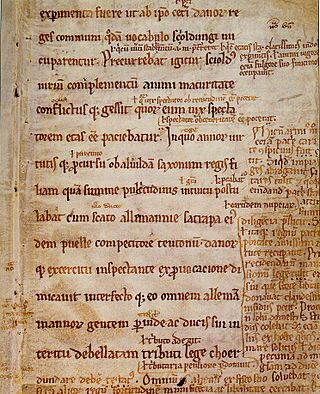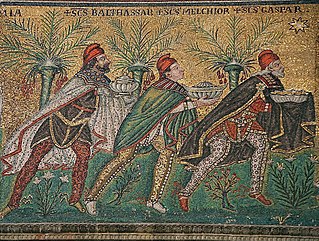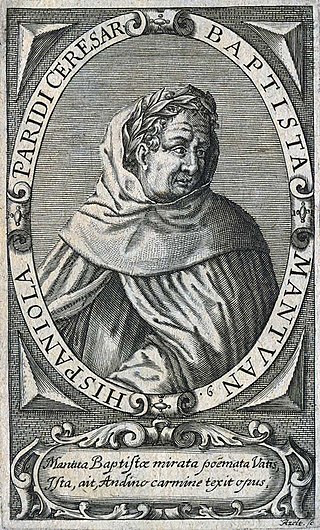Related Research Articles

Gesta Danorum is a patriotic work of Danish history, by the 12th-century author Saxo Grammaticus. It is the most ambitious literary undertaking of medieval Denmark and is an essential source for the nation's early history. It is also one of the oldest known written documents about the history of Estonia and Latvia.

Geoffrey of Monmouth was a Catholic cleric from Monmouth, Wales, and one of the major figures in the development of British historiography and the popularity of tales of King Arthur. He is best known for his chronicle The History of the Kings of Britain which was widely popular in its day, being translated into other languages from its original Latin. It was given historical credence well into the 16th century, but is now considered historically unreliable.

The Shrine of the Three Kings, Tomb of the Three Kings, or Tomb of the Three Magi is a reliquary traditionally believed to contain the bones of the Biblical Magi, also known as the Three Kings or the Three Wise Men. The shrine is a large gilded and decorated triple sarcophagus placed above and behind the high altar of Cologne Cathedral in western Germany. Built approximately from 1180 to 1225, it is considered the high point of Mosan art and the largest reliquary in the Western world.
William of Malmesbury was the foremost English historian of the 12th century. He has been ranked among the most talented English historians since Bede. Modern historian C. Warren Hollister described him as "a gifted historical scholar and an omnivorous reader, impressively well versed in the literature of classical, patristic, and earlier medieval times as well as in the writings of his own contemporaries. Indeed William may well have been the most learned man in twelfth-century Western Europe."

The biblical Magi —also referred to as the (Three) Wise Men, (Three) Kings, and the (Three) Magi—were distinguished foreigners in the Gospel of Matthew and Christian tradition. They are said to have visited Jesus after his birth, bearing gifts of gold, frankincense, and myrrh. They are regular figures in traditional accounts of the nativity celebrations of Christmas and are an important part of Christian tradition.

Historia regum Britanniae, originally called De gestis Britonum, is a pseudohistorical account of British history, written around 1136 by Geoffrey of Monmouth. It chronicles the lives of the kings of the Britons over the course of two thousand years, beginning with the Trojans founding the British nation and continuing until the Anglo-Saxons assumed control of much of Britain around the 7th century. It is one of the central pieces of the Matter of Britain.

Gondophares I was the founder of the Indo-Parthian Kingdom and its most prominent king, ruling from 19 to 46. He probably belonged to a line of local princes who had governed the Parthian province of Drangiana since its disruption by the Indo-Scythians in c. 129 BC, and may have been a member of the House of Suren. During his reign, his kingdom became independent from Parthian authority and was transformed into an empire, which encompassed Drangiana, Arachosia, and Gandhara. He is generally known from the Acts of Thomas, the Takht-i-Bahi inscription, and silver and copper coins bearing his visage.

The Rite of the Holy Sepulchre, commonly called the Carmelite Rite, is the liturgical rite that was used by the Canons Regular of the Holy Sepulchre, Hospitallers, Templars, Carmelites and the other orders founded within the Latin Patriarchate of Jerusalem.
Byrhtferth was a priest and monk who lived at Ramsey Abbey in Huntingdonshire in England. He had a deep impact on the intellectual life of later Anglo-Saxon England and wrote many computistic, hagiographic, and historical works. He was a leading man of science and best known as the author of many different works. His Manual (Enchiridion), a scientific textbook, is Byrhtferth's best known work.

Baptista Spagnuoli Mantuanus, O.Carm was an Italian Carmelite reformer, humanist, and poet.

The Basilica of Sant'Eustorgio is a church in Milan in northern Italy, which is in the Basilicas Park city park. It was for many years an important stop for pilgrims on their journey to Rome or to the Holy Land, because it was said to contain the tomb of the Three Magi or Three Kings.
The Gesta Regum Anglorum, originally titled De Gestis Regum Anglorum and also anglicized as The Chronicles or The History of the Kings of England, is an early-12th-century history of the kings of England by William of Malmesbury. It is a companion work of his Gesta Pontificum Anglorum and was followed by his Historia Novella, which continued its account for several more years. The portions of the work concerning the First Crusade were derived from Gesta Francorum Iherusalem peregrinantium, a chronicle by Fulcher of Chartres.
The Book of the First Monks is a medieval Catholic book in the contemplative and eremitic tradition of the Carmelite Order, thought to reflect the spirituality of the Prophet Elijah, honored as the Father of the Order.

John Bird was an English Carmelite friar and subsequently a bishop.

Brut y Brenhinedd is a collection of variant Middle Welsh versions of Geoffrey of Monmouth's Latin Historia Regum Britanniae. About 60 versions survive, with the earliest dating to the mid-13th century. Adaptations of Geoffrey's Historia were extremely popular throughout Western Europe during the Middle Ages, but the Brut proved especially influential in medieval Wales, where it was largely regarded as an accurate account of the early history of the Celtic Britons.
Walter of Oxford was a cleric and writer. He served as archdeacon of Oxford in the 12th century. Walter was a friend of Geoffrey of Monmouth, who claimed he got his chief source for the Historia Regum Britanniae from him.
Robert Bale, O.Carm. was an English Carmelite friar and scholar.
Richard of Lavenham was an English Carmelite, known as a scholastic philosopher. He is now remembered for his approach to the problem of future contingents.

Saint Caspar was one of the 'Three Kings', along with Melchior and Balthazar, representing the wise men or Biblical Magi mentioned in the Bible in the Gospel of Matthew, verses 2:1-9. Although the Bible does not specify who or what the Magi were, since the seventh century, the Magi have been identified in Western Christianity as Caspar, Melchior and Balthasar. Caspar and the other two are considered saints by the Catholic Church.

John of St. Samson (1571–1636), also known as Jean du Moulin or Jean de Saint-Samson, was a French Carmelite friar and mystic of the Catholic Church. He is known as the soul of the Touraine Reform of the Carmelite Order, which stressed prayer, silence and solitude. John was blind from the age of three after contracting smallpox and receiving poor medical treatment for the disease. He insisted very strongly on the mystical devotion of the Carmelites. He has been referred to as the "French John of the Cross" by students of Christian mysticism.
References
- Rudolph Hendriks (ed.), “A Register of the Letters and Papers of John of Hildesheim, O.Carm.” Carmelus 4 (1957): 116–235.